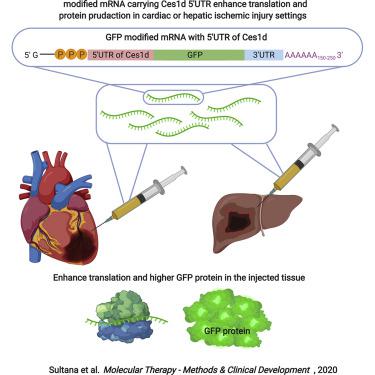当前位置:
X-MOL 学术
›
Mol. Ther. Methods Clin. Dev.
›
论文详情
Our official English website, www.x-mol.net, welcomes your
feedback! (Note: you will need to create a separate account there.)
Optimization of 5' Untranslated Region of Modified mRNA for Use in Cardiac or Hepatic Ischemic Injury.
Molecular Therapy - Methods & Clinical Development ( IF 4.6 ) Pub Date : 2020-03-31 , DOI: 10.1016/j.omtm.2020.03.019 Nishat Sultana 1, 2, 3 , Yoav Hadas 1, 2, 3 , Mohammad Tofael Kabir Sharkar 1, 2, 3 , Keerat Kaur 1, 2, 3 , Ajit Magadum 1, 2, 3 , Ann Anu Kurian 1, 2, 3 , Nadia Hossain 1, 2, 3 , Bremy Alburquerque 1, 2, 3 , Sakib Ahmed 1, 2, 3 , Elena Chepurko 1, 2, 3 , Lior Zangi 1, 2, 3
Molecular Therapy - Methods & Clinical Development ( IF 4.6 ) Pub Date : 2020-03-31 , DOI: 10.1016/j.omtm.2020.03.019 Nishat Sultana 1, 2, 3 , Yoav Hadas 1, 2, 3 , Mohammad Tofael Kabir Sharkar 1, 2, 3 , Keerat Kaur 1, 2, 3 , Ajit Magadum 1, 2, 3 , Ann Anu Kurian 1, 2, 3 , Nadia Hossain 1, 2, 3 , Bremy Alburquerque 1, 2, 3 , Sakib Ahmed 1, 2, 3 , Elena Chepurko 1, 2, 3 , Lior Zangi 1, 2, 3
Affiliation

|
Modified mRNA (modRNA) is a gene-delivery platform for transiently introducing a single gene or several genes of interest to different cell types and tissues. modRNA is considered to be a safe vector for gene transfer, as it negligibly activates the innate immune system and does not compromise the genome integrity. The use of modRNA in basic and translational science is rising, due to the clinical potential of modRNA. We are currently using modRNA to induce cardiac regeneration post-ischemic injury. Major obstacles in using modRNA for cardiac ischemic disease include the need for the direct and single administration of modRNA to the heart and the inefficient translation of modRNA due to its short half-life. Modulation of the 5' untranslated region (5' UTR) to enhance translation efficiency in ischemic cardiac disease has great value, as it can reduce the amount of modRNA needed per delivery and will achieve higher and longer protein production post-single delivery. Here, we identified that 5' UTR, from the fatty acid metabolism gene carboxylesterase 1D (Ces1d), enhanced the translation of firefly luciferase (Luc) modRNA by 2-fold in the heart post-myocardial infarction (MI). Moreover, we identified, in the Ces1d, a specific RNA element (element D) that is responsible for the improvement of modRNA translation and leads to a 2.5-fold translation increment over Luc modRNA carrying artificial 5' UTR, post-MI. Importantly, we were able to show that 5' UTR Ces1d also enhances modRNA translation in the liver, but not in the kidney, post-ischemic injury, indicating that Ces1d 5' UTR and element D may play a wider role in translation of protein under an ischemic condition.
中文翻译:

用于心脏或肝脏缺血性损伤的修饰 mRNA 5' 非翻译区的优化。
修饰的 mRNA (modRNA) 是一种基因传递平台,用于将单个基因或多个感兴趣的基因瞬时引入不同的细胞类型和组织。 modRNA 被认为是基因转移的安全载体,因为它对先天免疫系统的激活作用可以忽略不计,并且不会损害基因组完整性。由于 modRNA 的临床潜力,modRNA 在基础科学和转化科学中的使用正在增加。我们目前正在使用 modRNA 来诱导缺血性损伤后的心脏再生。使用modRNA治疗心脏缺血性疾病的主要障碍包括需要将modRNA直接单次施用到心脏以及由于其半衰期短而导致modRNA翻译效率低下。调节 5' 非翻译区 (5' UTR) 以提高缺血性心脏病中的翻译效率具有巨大价值,因为它可以减少每次递送所需的 modRNA 量,并且将在单次递送后实现更高和更长的蛋白质生产。在这里,我们发现来自脂肪酸代谢基因羧酸酯酶 1D (Ces1d) 的 5' UTR 在心肌梗死 (MI) 后的心脏中将萤火虫荧光素酶 (Luc) modRNA 的翻译增强了 2 倍。此外,我们在 Ces1d 中发现了一个特定的 RNA 元件(元件 D),它负责 modRNA 翻译的改进,并导致 MI 后比携带人工 5' UTR 的 Luc modRNA 翻译增量 2.5 倍。重要的是,我们能够证明 Ces1d 5' UTR 也能增强缺血性损伤后肝脏中的 modRNA 翻译,但不会增强肾脏中的 modRNA 翻译,这表明 Ces1d 5' UTR 和元件 D 可能在缺血性损伤后的蛋白质翻译中发挥更广泛的作用。缺血状态。
更新日期:2020-03-31
中文翻译:

用于心脏或肝脏缺血性损伤的修饰 mRNA 5' 非翻译区的优化。
修饰的 mRNA (modRNA) 是一种基因传递平台,用于将单个基因或多个感兴趣的基因瞬时引入不同的细胞类型和组织。 modRNA 被认为是基因转移的安全载体,因为它对先天免疫系统的激活作用可以忽略不计,并且不会损害基因组完整性。由于 modRNA 的临床潜力,modRNA 在基础科学和转化科学中的使用正在增加。我们目前正在使用 modRNA 来诱导缺血性损伤后的心脏再生。使用modRNA治疗心脏缺血性疾病的主要障碍包括需要将modRNA直接单次施用到心脏以及由于其半衰期短而导致modRNA翻译效率低下。调节 5' 非翻译区 (5' UTR) 以提高缺血性心脏病中的翻译效率具有巨大价值,因为它可以减少每次递送所需的 modRNA 量,并且将在单次递送后实现更高和更长的蛋白质生产。在这里,我们发现来自脂肪酸代谢基因羧酸酯酶 1D (Ces1d) 的 5' UTR 在心肌梗死 (MI) 后的心脏中将萤火虫荧光素酶 (Luc) modRNA 的翻译增强了 2 倍。此外,我们在 Ces1d 中发现了一个特定的 RNA 元件(元件 D),它负责 modRNA 翻译的改进,并导致 MI 后比携带人工 5' UTR 的 Luc modRNA 翻译增量 2.5 倍。重要的是,我们能够证明 Ces1d 5' UTR 也能增强缺血性损伤后肝脏中的 modRNA 翻译,但不会增强肾脏中的 modRNA 翻译,这表明 Ces1d 5' UTR 和元件 D 可能在缺血性损伤后的蛋白质翻译中发挥更广泛的作用。缺血状态。











































 京公网安备 11010802027423号
京公网安备 11010802027423号